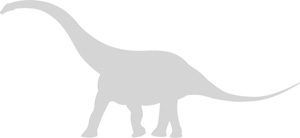Every month, 100,000 readers use the Dinosaur Database, but we receive no support from you. Developing and updating the database requires a lot of work. If you want it to remain open and be updated, please support us via the "Buy us a coffee" button available on every page or via the Support page.
Dinosaur: Uriash kadici

| Length*: | 13.4 m | 44.0 ft |
| Weight*: | 5.4 t | 11,905 lb |
*The largest known specimen
Period
Epoch: Late Cretaceous
Stage: Maastrichtian
Years: 72.1–66 Ma
Details
Status: valid
Author: Díez Díaz et al.
Year: 2025
Distribution
Area: Europe
Country: Romania
Region: Hațeg Basin
Formation: Densuș-Ciula
Description
Uriash kadici
Uriash kadici is a genus of titanosaurian sauropod dinosaur from the Late Cretaceous (Maastrichtian stage), approximately 70–66 million years ago. Its fossils were discovered in the Hațeg Basin of Romania, an area known for its rich assemblage of dwarf dinosaur species. The genus name Uriash derives from the Romanian word “uriaș,” meaning “giant,” referencing Romanian folklore. The species name kadici honors Hungarian geologist Ottokár Kadić (1876–1957) for his contributions to the geology of the region.
Physical Characteristics
Uriash kadici was a medium-sized titanosaur, estimated to reach 10–12 meters (33–39 feet) in length. As a sauropod, it possessed a long neck and tail, a massive body, and columnar limbs. Notable skeletal features include:
- Humerus: The right humerus (SZTFH Ob.3104) exhibits a midline longitudinal convexity along the posterior shaft that curves distally toward the medial edge. Additionally, it has a prominent deltopectoral crest and a large, proximodistally elongated oval foramen in the posterolateral depression of the proximal humerus.
- Femur: The right femur (SZRFH Ob.3103) shows a shaft that begins to transversely expand distally near its midlength. A hypertrophied fourth trochanter is also present, indicating robust musculature.
- Metatarsal I: The left metatarsal I (SZTFH Ob.3095) is well-preserved, providing insights into the foot structure and weight-bearing adaptations of the species.
These unique features distinguish Uriash kadici from other titanosaurs and suggest specific adaptations in limb morphology.
Diet and Feeding Habits
As a herbivorous dinosaur, Uriash kadici likely fed on a variety of vegetation, including conifers, ferns, and angiosperms. Its long neck would have allowed it to access a broad range of plant material, from ground level to mid-canopy heights. The dentition and jaw structure suggest it was adapted for cropping vegetation rather than chewing, relying on gastroliths and a large digestive system to process food.
Habitat and Distribution
Uriash kadici inhabited the Hațeg Island, a landmass in the European archipelago during the Late Cretaceous, corresponding to present-day Romania. This insular environment was characterized by a unique ecosystem with limited resources, leading to the evolution of both dwarf and medium-sized dinosaur species. The Hațeg Basin’s sedimentary deposits indicate a landscape of rivers, floodplains, and forested areas, providing a diverse habitat for its fauna.
The region was home to various contemporaneous species, including:
- Nodosaurids: Armored dinosaurs like Struthiosaurus.
- Rhabdodontids: Ornithopod dinosaurs such as Zalmoxes.
- Theropods: Predatory dinosaurs including Balaur.
The coexistence of these species suggests a complex ecosystem with various ecological niches.
Behavior and Social Structure
While direct evidence of the behavior of Uriash kadici is limited, inferences can be made based on related sauropods. It may have lived in small herds or as solitary individuals, depending on resource availability. The robust limb bones and specific adaptations suggest it was well-suited for traversing the varied terrain of Hațeg Island. Its size would have offered protection against most predators, though juveniles may have been more vulnerable.
Discovery and Research
The holotype specimen, consisting of a right humerus (SZTFH Ob.3104), right femur (SZRFH Ob.3103), and left metatarsal I (SZTFH Ob.3095), was discovered in the Hațeg Basin. Initially, these fossils were referred to Petrustitan, but a comprehensive revision by Díez Díaz et al. in 2025 recognized them as a distinct genus and species, Uriash kadici.
This revision highlighted the high diversity of titanosaur species in the region and provided new insights into the paleobiogeography of Late Cretaceous Europe.
Significance and Interesting Facts
- Insular Dwarfism and Gigantism: The Hațeg Island is renowned for its dwarf dinosaur species. Uriash kadici, being medium-sized, adds complexity to our understanding of how isolation and limited resources influenced dinosaur evolution on islands.
- Unique Limb Morphology: The distinct features of the humerus and femur suggest specialized locomotor adaptations, possibly related to the island’s varied terrain.
- Etymological Tribute: The genus and species names honor both Romanian folklore and a notable Hungarian geologist, reflecting the rich cultural and scientific heritage of the region.
- Paleobiogeographical Insights: The discovery of Uriash kadici contributes to our understanding of titanosaur distribution and evolution in Late Cretaceous Europe, indicating faunal exchanges between landmasses.
- Holotype Specifics: The well-preserved nature of the holotype bones provides valuable anatomical information, aiding in the reconstruction of the species’ physiology and biomechanics.
Locations
Sources
Material: Holotype of Uriash kadici is SZTFH Ob.3104; right femur (SZRFH Ob.3103), left metatarsal I (SZTFH Ob.3095)
References: Díez Díaz, Verónica; Mannion, Philip D.; Csiki-Sava, Zoltán; Upchurch, Paul (20 February 2025). "Revision of Romanian sauropod dinosaurs reveals high titanosaur diversity and body-size disparity on the latest Cretaceous Haţeg Island, with implications for titanosaurian biogeography". Journal of Systematic Palaeontology



